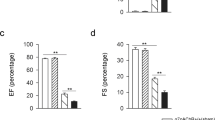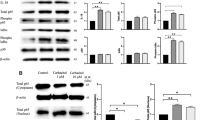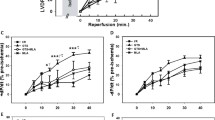Abstract
Activation of α-7 nicotinic acetylcholine receptor (α7nAChR) receptor might induce cardiac inflammation, cardiac remodeling, and dysfunction. In this regard, this study aims to clarify the role and mechanism of α7nAChR in the process of cardiac inflammation and damage. Normal male C57BL/6J and NLRP3-knockout mice were used to evaluate the effect of PHA-543613, a selective agonist of α7nAChR, on cardiac inflammation and possible involvement of NLRP3/Caspase-1/IL-18 using western blotting and ELISA. Activation of α7nAChR using PHA-543613 (NE), at the doses of 0.5 mg/kg and 1 mg/kg, induced cardiac inflammation. In addition, both in vivo and in vitro studies showed higher expression of NLRP3 and higher activation of Caspase-1 and IL-18 after treating animals with NE. On the other hand, we did not observe any significant changes in inflammatory cytokines and cardiac inflammation after administration of NE in NLRP3-knockout mice. It could be concluded that blocking the NLRP3/Caspase-1/IL-18 pathway can simultaneously inhibit the inflammatory response mediated by α7nAChR and it would a novel target for inhibiting cardiac inflammation and remodeling.




Similar content being viewed by others
Data Availability
All data will be available on reasonable request.
References
Abderrazak A, Syrovets T, Couchie D, El Hadri K, Friguet B, Simmet T et al (2015) NLRP3 inflammasome: from a danger signal sensor to a regulatory node of oxidative stress and inflammatory diseases. Redox Biol 4:296–307
Allen IC, Scull MA, Moore CB, Holl EK, McElvania-TeKippe E, Taxman DJ et al (2009) The NLRP3 inflammasome mediates in vivo innate immunity to influenza A virus through recognition of viral RNA. Immunity 30(4):556–565
Bacmeister L, Schwarzl M, Warnke S, Stoffers B, Blankenberg S, Westermann D et al (2019) Inflammation and fibrosis in murine models of heart failure. Basic Res Cardiol 114(3):19
Bajpai G, Bredemeyer A, Li W, Zaitsev K, Koenig AL, Lokshina I et al (2019) Tissue resident CCR2− and CCR2+ cardiac macrophages differentially orchestrate monocyte recruitment and fate specification following myocardial injury. Circ Res 124(2):263–278
Barretto ACP, Santos AC, Munhoz R, Rondon MUPB, Franco FG, Trombetta IC et al (2009) Increased muscle sympathetic nerve activity predicts mortality in heart failure patients. Int J Cardiol 135(3):302–307
Farré-Alins V, Narros-Fernández P, Palomino-Antolín A, Decouty-Pérez C, Lopez-Rodriguez AB, Parada E, Muñoz-Montero A, Gómez-Rangel V, López-Muñoz F, Ramos E, González-Rodríguez Á (2020) Melatonin reduces NLRP3 inflammasome activation by increasing α7 nAChR-mediated autophagic flux. Antioxidants 9(12):1299
Foucault-Fruchard L, Domene A, Page G, Windsor M, Emond P, Rodrigues N et al (2017) Neuroprotective effect of the alpha 7 nicotinic receptor agonist PHA 543613 in an in vivo excitotoxic adult rat model. Neuroscience 356:52–63
González A, Ravassa S, López B, Moreno MU, Beaumont J, San José G et al (2018) Myocardial remodeling in hypertension: toward a new view of hypertensive heart disease. Hypertension 72(3):549–558
Gu L, Tseng SC, Rollins BJ (1999) Monocyte chemoattractant protein-1. Chem Immunol 72:7
Hoover DB (2017) Cholinergic modulation of the immune system presents new approaches for treating inflammation. Pharmacol Ther 179:1–16
Huston JM, Tracey KJ (2011) The pulse of inflammation: heart rate variability, the cholinergic anti-inflammatory pathway and implications for therapy. J Intern Med 269(1):45–53
Jiang T, Wu M, Zhang Z, Yan C, Ma Z, He S, Yuan W, Pu K, Wang Q (2019) Electroacupuncture attenuated cerebral ischemic injury and neuroinflammation through α7nAChR-mediated inhibition of NLRP3 inflammasome in stroke rats. Mol Med 25(1):1–3
Kaur K, Sharma AK, Singal PK (2006) Significance of changes in TNF-α and IL-10 levels in the progression of heart failure subsequent to myocardial infarction. Am J Physiol Circ Physiol 291(1):H106–H113
Kox M, Van Velzen JF, Pompe JC, Hoedemaekers CW, Van Der Hoeven JG, Pickkers P (2009) GTS-21 inhibits pro-inflammatory cytokine release independent of the Toll-like receptor stimulated via a transcriptional mechanism involving JAK2 activation. Biochem Pharmacol 78(7):863–872
Liu W-H, Wang F, Yu X-Q, Wu H, Gong M-L, Chen R et al (2020) Damaged male germ cells induce epididymitis in mice. Asian J Androl 22(5):472
Mazloom R, Eftekhari G, Rahimi M, Khori V, Hajizadeh S, Dehpour AR, Mani AR (2013) The role of α7 nicotinic acetylcholine receptor in modulation of heart rate dynamics in endotoxemic rats. PLoS ONE 8(12):e82251
Nikolic VN, Jevtovic-Stoimenov T, Stokanovic D, Milovanovic M, Velickovic-Radovanovic R, Pesic S et al (2013) An inverse correlation between TNF alpha serum levels and heart rate variability in patients with heart failure. J Cardiol 62(1):37–43
Ren C, Li X, Wang S, Wang L, Dong N, Wu Y et al (2018) Activation of central alpha 7 nicotinic acetylcholine receptor reverses suppressed immune function of T lymphocytes and protects against sepsis lethality. Int J Biol Sci 14(7):748
Scherer EBS, Loureiro SO, Vuaden FC, da Cunha AA, Schmitz F, Kolling J et al (2014) Mild hyperhomocysteinemia increases brain acetylcholinesterase and proinflammatory cytokine levels in different tissues. Mol Neurobiol 50(2):589–596
Tracey KJ, Huston JM (2014) Inhibition of inflammatory cytokine production by cholinergic agonists and vagus nerve stimulation. Google Patents
Yang Y, Fang H, Zhao M, Wei X, Zhang N, Wang S et al (2017) Specific α7 nicotinic acetylcholine receptor agonist ameliorates isoproterenol-induced cardiac remodelling in mice through TGF-β1/Smad3 pathway. Clin Exp Pharmacol Physiol 44(12):1192–1200
Zhou Z, Wang Z, Guan Q, Qiu F, Li Y, Liu Z et al (2016) PEDF inhibits the activation of NLRP3 inflammasome in hypoxia cardiomyocytes through PEDF receptor/phospholipase A2. Int J Mol Sci 17(12):2064
Acknowledgements
The research is supported by The Scientific Research Project in 2017 of Hunan Provincial Education Department “Intrauterine origin of GR/MR-mediated cardiac injury induced by dexamethasone exposure during pregnancy in rats” (17C1482) and The Scientific Research Project in 2017 of Xiangnan University “Effect of DEX overexposure during pregnancy on the expression of TRPM7 in fetal rat heart” (2017XJ24) and Characteristic Subjects of Pharmaceutical Application in Hunan Province (2018-469).
Funding
None.
Author information
Authors and Affiliations
Contributions
ZG, BT, JW, WT, LP, YC, and JZ conceived and designed the study, collected subjects, performed experiments, analyzed the data and participated in the discussion, and wrote and revised the manuscript. All authors read and approved the final manuscript.
Corresponding author
Ethics declarations
Conflict of interest
All authors declare that there is no conflict of interest.
Ethical Approval
Our study was in accordance with the National Institute of Health (NIH) Guidelines for the Care and Use of Laboratory Animals (HHS Publication 85-23, 1985), legislation for the protection of animals used for scientific purposes (Directive 2010/63/EU). Euthanasia was done using 7-min exposure to CO2 and followed by cervical dislocation for confirmation of death.
Consent for Publication
All authors read the journals guideline and agreed with consent for publication.
Additional information
Publisher's Note
Springer Nature remains neutral with regard to jurisdictional claims in published maps and institutional affiliations.
Rights and permissions
About this article
Cite this article
Guo, Z., Tan, B., Wang, J. et al. Activation of α-7 Nicotinic Acetylcholine Receptor Attenuates Cardiac Inflammation Through NLRP3/Caspase-1/IL-18 Pathway. Biochem Genet 60, 1333–1345 (2022). https://doi.org/10.1007/s10528-021-10162-8
Received:
Accepted:
Published:
Issue Date:
DOI: https://doi.org/10.1007/s10528-021-10162-8




